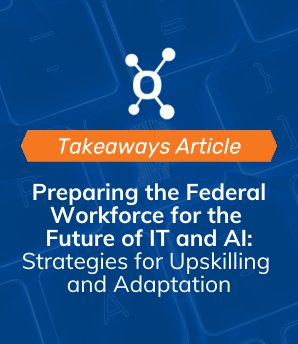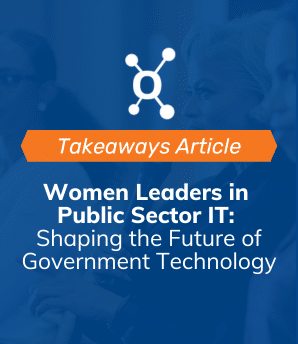As technical advancements enter the public sector workforce at a rapid rate, there’s more importance than ever before on security and risk management. Emerging technologies, like Artificial Intelligence, promise to revolutionize public service, but there are implications of vulnerabilities that public sector workers must consider before diving in headfirst.
Leadership Connect hosted a webinar discussing this topic with esteemed experts – Dr. Robert Irie, Director of Science and Technology Program Protection for the U.S. Department of Defense, and Gordon Bitko, Senior Vice President of Policy for the Information Technology Industry Council – to help our audience navigate this complex field of emerging technologies and security and where the two meet.
Here are a few of the key takeaways from the discussion:
Balancing the tension: Responsible governance and risk management
Our panelists discussed the inherent tension that exists between rushing to implement emerging technology, while also taking the proper precautions to adhere to security standards. Here are a few thoughts they had on the matter:
- Refer to any guidance provided by higher levels of influence, like the DOD, regarding responsible implementation of emerging technologies.
- Acknowledge that some risk must be accepted when making significant advancements in technology.
- Start by defining terms in emerging tech so that everyone is on the same page regarding collective definitions.
- Use tools and resources to identify and characterize risks to make an informed decision prior to moving forward.
- Utilize partnerships with government and academia to increase knowledge and conversations surrounding emerging technologies prior to implementation.
- Find the balance between the need for expanded technology and human input. Gordon walked our audience through this thought with the example of law enforcement and how there’s a massive increase of facial recognition data today from cell phones and cameras, causing an increased need for balance between modernizing technology to handle the influx of data while also incorporating human review.
Determining the value and finding rewards in emerging technologies
Robert and Gordon explained that after assessing risks, the next steps in implementing emerging technologies are very important. Given the potential security risks, they agreed that it’s of the utmost importance for teams to prove the worth of the new tech as quickly as possible. Here is some of their advice:
- Only move forward with implementation after properly assessing the risks, as discussed above.
- This process ideally starts with rapid prototyping and experimentation to quickly show the value of that emerging technology.
- Rapid prototyping quickly shows the possibility of the new technology and how it could become a capability for the organization.
- Acquiring capabilities is the most important thing in emerging technologies, so demonstrating that value is essential to moving forward.
- Weighing the balance of a small use cases versus a larger impact on the total workforce is something that both panelists agreed has no singular solution. They recommended further conversations with partnerships and allies to determine the use cases of each emerging tech as it pertains to each organization.
Keeping the process moving
Implementing emerging technology comes with a lot of roadblocks along the way. Here’s what Robert and Gordon had to say about keeping the process moving efficiently:
- Robert suggested that visiting the DOD website https://www.ctoinnovation.mil/ is the best way to identify areas where emerging technology could be useful. By engaging with the defense innovation ecosystem through this central location, you can get a better sense of what emerging tech is being used in the public sector. Having the context behind the suggested technology makes it easier to start the implementation process.
- You can also start by analyzing internal processes regarding engagement with an emphasis on partnerships and allies. Robert used the example of DARPA Bridges — with collaboration from partners, the need for a way to use emerging tech to declassify infrastructures to start conversations across government became apparent.
- Our panelists also addressed the “Valley of Death,” the mid-stages of technical development where things tend to taper off and progress is stalled. They suggested building a response to this into the process by acknowledging that there are many obstacles to overcome throughout the lifecycle of a new technology. By building in a stage to wholistically identify and prepare for those barriers, you can be better equipped to avoid or quickly move through the “Valley of Death.”
Missed the discussion and want to learn more? Check it out here! Check in with our Events page and our LinkedIn to make sure you don’t miss the next webinar.






